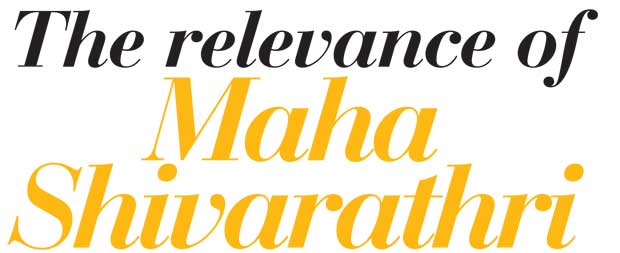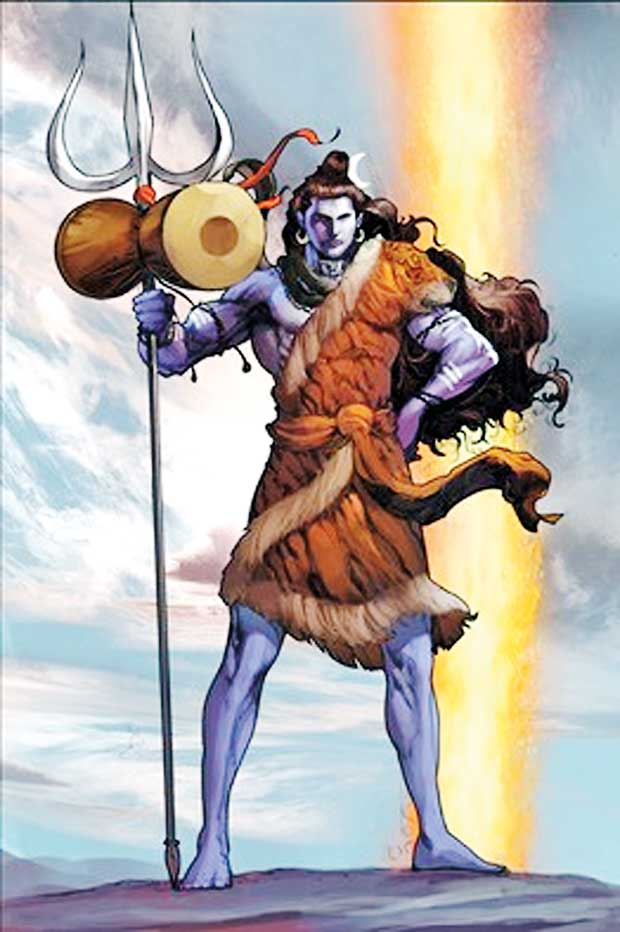Reply To:
Name - Reply Comment
Last Updated : 2024-04-19 14:00:00

Today Hindus in Sri Lanka and in many parts of the world observe the Maha Shivarathri -the night long vigil and prayer offered to the Supreme Being known as Sivaperuman by Tamil Saivaites.
It is about taking refuge in the divine consciousness, which brings peace and solace to all layers of consciousness.
Shiva is considered to be the supreme of the triumvirate of the Hindu Pantheon, the other two being Vishnu and Brahma (Brahma should not be confused with Brahman or Para Brahman the “Highest Brahman” that which is beyond all descriptions and conceptualisations.
Shiva is also known by other names Ishwara, Nataraja, Neelakanda and many more. He has thousands of names. The Nataraja form signifies why Shiva is the Supreme Being. The dance form is  all about creative destruction.
all about creative destruction.
In Vaishnavism and Shaivism Vishnu and Shiva, respectively, are Para Brahman. In Advaita Vedanta, Nirguna Brahman (Brahman without qualities) is Para Brahman.
Today is called Maha Shivarathri as there are 12 Shivarathries occurring every month.
It is a major festival in Hinduism, but one that is solemn and marks a remembrance of “overcoming darkness and ignorance” in life similar to that of Deepavali.
As common in Hindu thought, the concept behind the observance has theological meanings. But these concepts are related to children and the lay, in forms of stories so that once they gain spiritual maturity, they understand the true meaning behind.
One of the important features of Shivarathri is that like Hinduism itself, the origin of the observance is not known.

Shivarathri is observed by remembering Shiva and chanting prayers, fasting, doing Yoga and meditating on ethics and virtues such as self-restraint, honesty, non-injury to others, forgiveness and the discovery of Shiva. The ardent devotees keep awake all night. Others visit one of the Shiva temples or go on pilgrimage to Jyotirlingams. This is an ancient Hindu festival whose date of origin is unknown. During the night six special Poojas are offered to Lord Shiva.
However, some of the laities thinking that being awake was the important aspect of the Maha Shivarathri, make it a movie marathon and go to the temple for important Poojas. Then there are others who keep awake till the midnight abishek Pooja as it is most important of all the Poojas that are held that night.
Incidentally, in Kashmir Saivism, the festival is called Har-ratri or phonetically simpler Haerath or Herath by Shiva faithfuls of the Kashmir region, according to some sources.
Every lunar month, there is a Shivarathri i.e. 12 every year. The most important one is called Maha Shivarathri, or great Shivarathri. According to the Gregorian calendar, the day falls in either February or March. One concept explains that Maha Shivarathri is the day when the Shiva Tattva touches the earth. The consciousness, the aura, or the ethereal world, which is always ten inches above the material ground, touches the earth element on the day of Maha Shivarathri. It is the coming together of the material and spiritual.
Rathri (night) is that which gives us rest, and peace. Rathri also could be interpreted as ‘to take refuge’. Thus Shivarathri is taking refuge in one’s own spirit (Shiva). It is the day that we try to understand our soul’s connection -that is none other than the Brahman -within ourselves as one’s true nature is Shiva, and Shiva is peace, infinity. Recently scientists of the empirical school announced that after death, the soul mixes with the Cosmic Energy or the Universe (Whatever they meant by that)
Puranas contain many stories and legends describing the origin of this festival. According to a legend in the Shiva Purana, once the other two of the triads of Hindu Gods, Brahma and Vishnu, were fighting over who was the superior of the two. Horrified at the intensity of the battle, the other gods asked Shiva to intervene. To make them realise the futility of their fight, Shiva assumed the form of a cosmic column of light in between Brahma and Vishnu. They were instructed by Shiva to find the top and the bottom of the light column to prove their superiority. Both failed.
The time Shiva showed up as the column of light is considered the Lingorpavam, which is that special midnight abishek Pooja of Maha Shivarathri.
Another legend explains the all-night worship of Shiva on Shivarathri. There was once a hunter who was a great devotee of Shiva. One day deep in the forest he lost his way and could not return home before nightfall. As darkness fell, he heard the growls of wild animals. Terrified, he climbed onto the nearest tree for shelter till day-break. Perched amongst the branches, he was afraid he would doze and fall off the tree. To stay awake, he decided to pluck a leaf at a time from the tree and drop it, while chanting the name of Shiva.
At dawn, he realised that he had dropped a thousand leaves onto a Linga which was under the trunk of the tree. The tree happened to be the Vilva or (Beli) tree. This unwitting all-night worship pleased Shiva, by whose grace the hunter was rewarded with divine bliss. This story is also recited on Mahashivaratri by devotees on fast. After observing the all-night fast, devotees eat the Prasad  offered to Shiva. There is another possible reason for the origin of the all-night worship. Being a moonless night, people worshipped the god who wore the crescent moon as an adornment in his hair, Shiva. This was probably to ensure that the moon rose the next night.
offered to Shiva. There is another possible reason for the origin of the all-night worship. Being a moonless night, people worshipped the god who wore the crescent moon as an adornment in his hair, Shiva. This was probably to ensure that the moon rose the next night.
Maha Shivarathri is thus not only a ritual but also a cosmic definition of the Hindu universe. It expected to dispel spiritual ignorance, and emanates the light of knowledge, makes one aware of one’s soul in the spiritual universe.
According to one puranic story, the devas and the asuras once tried to extract the elixir for eternity from the cosmic milk ocean by churning the ocean.
They used the Manthara mountain as their butter churn and used a serpent named Vasuki as the rope to churn the mountain. This implies that neither devas nor the ‘evil’ asuras are eternal. Devas are just the refined elite among the crowd, whereas the asuras are the trade union workers. In their own way it was agreed upon that the asuras would hold on the head of the serpent, while devas would hold the tail, in case.
During the churning process Vasuki the serpent because of the unbearable pain lets out its venom. The venom was so strong that both the devas and the asuras sought refuge in Shiva, who swallowed the venom and mitigated it. Some say the Maha Shivarathri marks this event. The symbolism involved in this story is beyond the scope of this article. The same motif is used as a basis for another Shiva Pooja known as Prathosham. But then one would also ask why would anyone want to mark Maha Shivarathri in this era? What relevance does it have? Why waste milk and other food on abishek while there are thousands of babies who go hungry?
Well, this goes beyond the material consumer world. The world that is felt by the physical bodies of living beings, especially ‘intelligent’ humans.
Unlike in other religions, for Hinduism the concept of Karma and rebirth according to Karma are very central. According to Hinduism the soul and the Para Brahman (Universal Energy) are infinite and eternal. Souls are eternal. So is Para Brahman. Humans are not destined or asked to rule over other beings-all are living beings (souls born into various material bodies) and one is born as a human being with intelligence based on the karma so that the soul is just one step away from leaving the samsara samudra (And become one with the Para Brahmam.
Technologies will come and go, but the process of being reborn and seeking refuge and rest will continue. Hence, the question is irrelevant as the questions are based on the material world.

Add comment
Comments will be edited (grammar, spelling and slang) and authorized at the discretion of Daily Mirror online. The website also has the right not to publish selected comments.
Reply To:
Name - Reply Comment
On March 26, a couple arriving from Thailand was arrested with 88 live animal
According to villagers from Naula-Moragolla out of 105 families 80 can afford
Is the situation in Sri Lanka so grim that locals harbour hope that they coul
A recent post on social media revealed that three purple-faced langurs near t